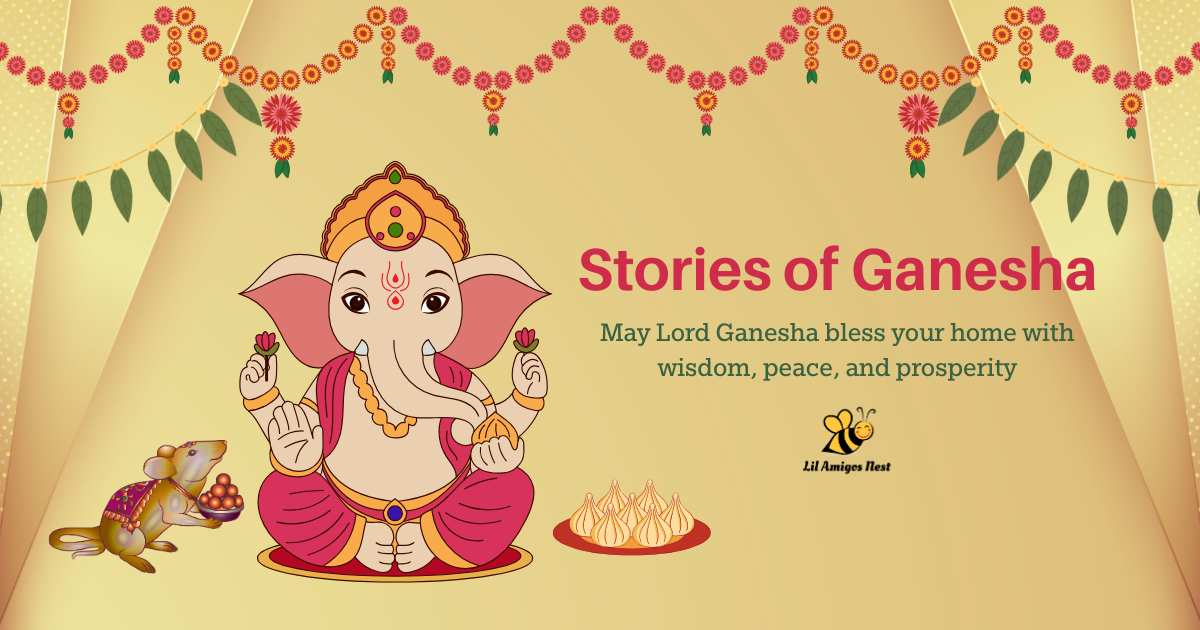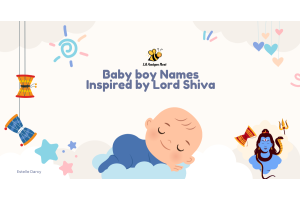Short Ganesha Stories for Kids

Celebrating Ganesh Chaturthi is a joyous moment for families around the world. Every year, devotees chant Ganpati Bappa Morya and welcome the elephant‑headed god into their homes. In Ganesh Chaturthi 2025, the festival will fall on Wednesday, August 27, 2025, marking ten days of devotion and merriment. From the Ganesh Chaturthi origin rooted in ancient legends to the spectacular immersion on September 6, each ritual reminds us why Lord Ganesha is revered as the remover of obstacles and the harbinger of wisdom.
This collection of Ganesh story retellings draws from classic Hindu stories to bring you little Ganesha story adventures that are perfect for young minds. Whether you’re exploring the Ganesh birth story, diving into mythological stories for kids, or simply enjoying short Ganesha stories, these tales of hope, courage, and playfulness will captivate children and spark their imagination. Each story is crafted in simple English and carries a gentle moral, keeping the content both humanized and accessible.
The Birth of Ganesha
Long ago, the goddess Parvati wished for a loyal guardian while she bathed. From the turmeric paste on her body, she shaped a little boy and breathed life into him. This child was Ganesha, whose skin gleamed like the morning sun. She named him Ganesha—“Ganesha birth story” indeed, for he embodied the perfect blend of purity and power.
When Lord Shiva returned home, the boy would not let him enter. Angered by this unknown guard, Shiva severed Ganesha’s head. Parvati’s grief echoed through the heavens. To console her, Shiva promised to restore her son’s life. He ordered his followers to find the head of the first living creature they met—an elephant! Thus, Ganesha returned with an elephant’s head, becoming the unique deity we celebrate today. This tale of creation and compassion underscores why Ganesha is the first god worshipped in any ritual.
How Ganesha Got His Mouse
After his transformation, Ganesha needed a vehicle, or vahana, to journey across realms. One day, a timid mouse named Mushika scurried by. With a swift stomp, Ganesha captured him under his foot. The mouse trembled, “Please spare me, Lord.” Amused by the creature’s boldness, Ganesha granted Mushika the honor of carrying him. From that day forward, the mouse became Ganesha’s loyal companion.
This little Ganesha story reminds us that even the smallest beings have a place in the divine universe. Mushika’s bravery and humility show that true strength comes not from size but from the heart.
The Clever Contest
Once, the gods devised a contest to test wisdom. They presented Ganesha and his brother Kartikeya with a challenge: whoever could circle the world three times fastest would win. Kartikeya mounted his peacock and soared into the sky. Ganesha, knowing his elephant form was slower, simply walked around his parents, Shiva and Parvati, three times and declared, “You are my entire world.” His clever reasoning won him the contest.
As you share this mythological story for kids, emphasize that wisdom often triumphs over speed or strength. Ganesha teaches us to look at challenges from a new perspective.
The Origin of the Modak Love
During the festival of Ganesh Chaturthi, sweets called modaks are offered to Ganesha. But why? Legend says Ganesha once found a pot of his favorite sweet—soft modaks filled with coconut and jaggery. He ate so many that his belly grew large and tight! To help him, his mother tickled him, causing a burst of laughter that popped the sweets back to his devotees.
This delightful Ganesha story explains why we chant Ganpati Bappa Morya while enjoying modaks today. The tale combines humor and family love, teaching kids that happiness and sharing go hand in hand.
Ganesha and the Curse of the Moon
One night, Ganesha was returning after feasting on modaks when he spotted the moon. “How bright!” he exclaimed. But as he pointed at it, the broken branch of his mount, the mouse, startled him. He fell, scattering his sweets. The moon laughed so hard that Ganesha’s anger boiled. In a flash, he cursed the moon: “You shall no longer shine.” Later, Ganesha relented, allowing the moon to wax and wane but forbidding it to show its face on his special day, Chaturthi.
This Hindu god story blends humor with a lesson: words have power, and apologies can heal. Children learn about respect and forgiveness through Ganesha’s interaction with the moon.
The Day Ganesha Wrote the Mahabharata
The great epic Mahabharata was said to be too vast to write by hand. Sage Vyasa sought Ganesha’s help. Ganesha agreed on one condition: Vyasa must recite without pause. Vyasa set his own term: Ganesha would understand the meaning before writing each line. Together, they created one of India’s greatest epics.
This Ganesh origin story highlights Ganesha’s role as the scribe of wisdom. It teaches children the importance of patience, intellect, and teamwork.
A Test of Patience
One day, sage Agastya invited all gods and humans to his ashram for a feast. Ganesha, busy teaching his mouse to dance, was the last to arrive. Annoyed by the delay, the sage offered Ganesha only a small bowl of milk. Undeterred, Ganesha dipped his tusks into the milk to scoop it up, drinking every drop. When his mother asked why he broke his tooth, he said, “To help those in need, every sacrifice is worth it.”
This gentle, short Ganesha story for kids shows that patience and cleverness can solve any problem, and sacrifice for others is a noble virtue.
The Lesson of Broken Tusk
Why does Ganesha have one tusk? Legends say he broke it off to write the Mahabharata. Another tale speaks of Ganesha battling a demon who shattered his tusk in hand-to-hand combat. Unfazed, Ganesha continued on his path. His single tusk thus stands as a symbol of resilience and focus.
Use this Hindu stories segment to encourage children: obstacles may break us, but they also make us stronger and wiser.
Ganesha’s Elephant Head as a Symbol
Ganesha’s elephant head represents wisdom (the large brain), strength (the strong trunk), and adaptability (the versatile trunk). His big ears remind us to listen more, while his small mouth teaches us to speak less. Sharing this Ganesh Chaturthi origin insight helps kids internalize the virtues of mindfulness and adaptability.
Bringing Ganesha Home
On Ganesh Chaturthi, families install clay idols of Ganesha at home and in pandals (temporary shrines). They decorate with flowers, chant mantras, and offer modaks and fruits. Over ten days, children learn hymns and stories of Ganesha’s life. On the final day, procession songs of “Ganpati Bappa Morya” accompany the procession to rivers or seas, symbolizing Ganesha’s return to Mount Kailash.
This annual ritual embeds moral lessons about community, devotion, and environmental mindfulness—clay idols dissolve harmlessly, teaching respect for nature.
The Enduring Appeal of Ganesha Stories
From his playful birth to his grand role in epic literature, Lord Ganesha remains one of the most beloved deities in mythological stories for kids. His tales blend humor, morals, and cultural values, making them perfect for young learners. As we prepare for Ganesh Chaturthi 2025, let these Ganesha stories inspire curiosity, kindness, and wisdom in every child.
By sharing these short Ganesha stories for kids, we pass on a living tradition—where every laugh echoes with ancient wisdom and every ritual strengthens our bond as a community.


























